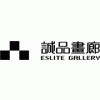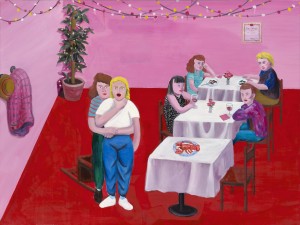 |
Eslite Gallery
5F, No. 11,
Songgao Road,
Taipei 11073, Taiwan map *
tel: +886 2 2775 5977
fax: +886 2 2775 1490
website
|

Enlarge
|
| Man‧Animal‧Landscape
|
|
| by Eslite Gallery
Location: Eslite Gallery
Artist(s): HUANG Hai-Hsin, LIN Yen Wei, LIN Wei-Hsiang
Date: 14 Jul - 5 Aug 2012
The exhibition title, “Man‧Animal‧Landscape,” refers to current themes in the works of young Taiwanese painters Hai-Hsin HUANG, LIN Yen Wei, and LIN Wei-Hsiang.
In Hai-Hsin HUANG’s works, the characters reflect a hyperreality of the media spectacle, with subjects based upon published or broadcasted photographic images from the media. She points out in her artist statement that as a part of the “comfortable and pleasure” generation, she wants to “practice,” through her images on the canvas, on how to deal with “suffering” and “crisis.”
Like safety drills, the works often give a comical and pretentious impression. Hai-Hsin HUANG creates a variety of “study” versions of suffering and crisis. Often twisted and deformed with a “peculiar” tone of ridicule while at the same time revealing a “strange sense of familiarity,” her paintings highlight the lives of Taiwan’s “easy and comfortable” generation, and in particular, their lightness of being.
LIN Yen Wei uses digital cameras to capture close-ups of animal heads and busts. Using depth of field, he deploys a painting style similar to that of photo-realism in the late 1960s. The animals in his paintings are actually renderings of ready-made sculpture objects found in the human world, all of them domesticated without exception, and has even become a pet. Their image is both directly and indirectly influenced by the forms of Disney animals.
Although his portraits are not of man, LIN Yen Wei’s cheap and coarse animal statues touches upon the real world, alluding to the industrialization and commercialization of the contemporary life. Human existence has long become materialized and is continuously changing due to the high turnover rate of commodities. The animal statues in his paintings contain human-like eyes and smiles, and can be regarded as a zoomorphic portrayal of man’s self-alienation in an age of consumerism.
The theme of LIN Wei-Hsiang’s works is significantly more classical than the two others. The little-changing monotony of the trees and rocks in a real world landscape are permeated with the artist’s solitary and unhurried personality. As he says himself, despite reality’s “impermanence” and a constantly “changing” present, he continues “depicting landscapes to serve as manifestations of objects and myself, a dialogue between visual and spiritual relationships and interactions.” The landscapes can “instantaneously” become “eternal.”
LIN Wei-Hsiang’s works are not only deeply rooted in the earth, but also float; they look both realistic as well as dream-like. When facing nature such as “landscape” and art such as “boundary,” LIN Wei-Hsiang consciously mediates between the two. Acutely aware of area between the “known” and “unknown,” he also looks forward to exploring unknown boundaries. |
|
|
|
|
